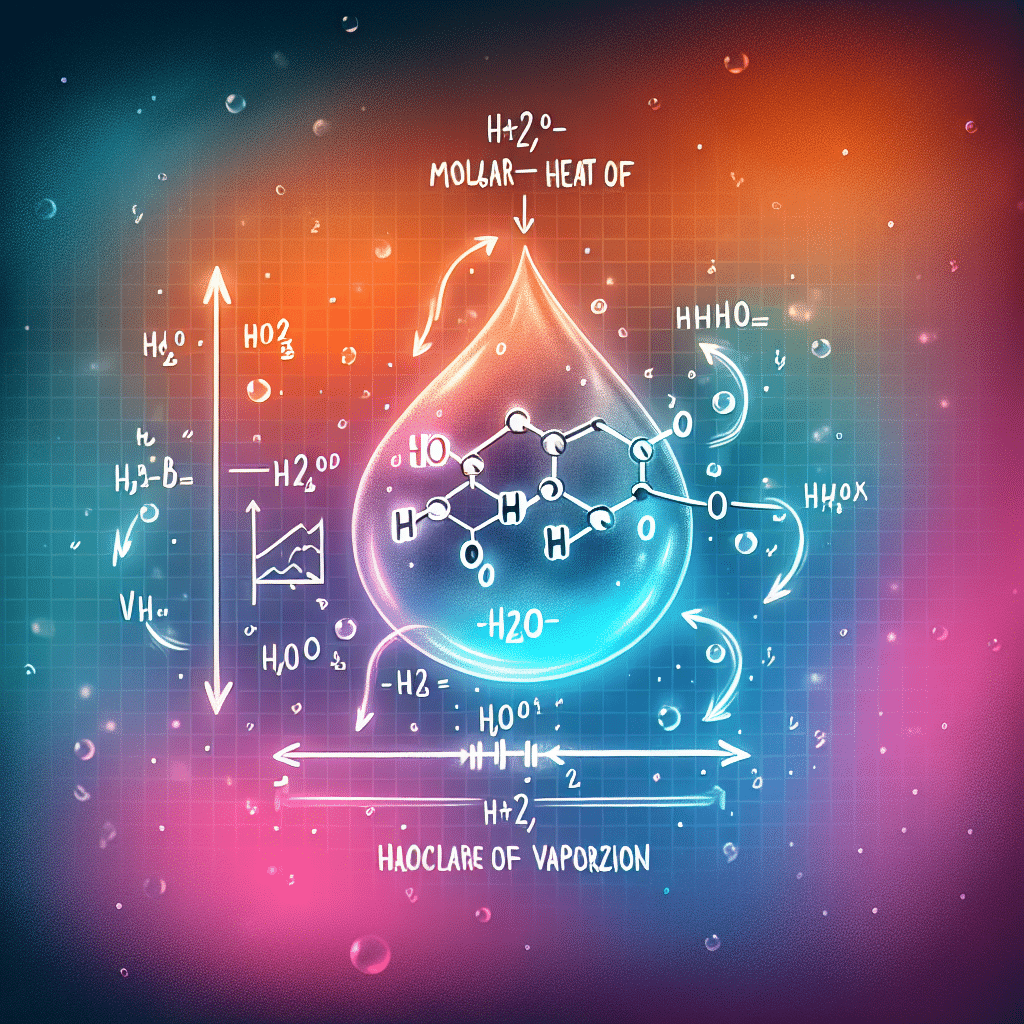Molar heat of vaporization of water refers to the amount of energy required to convert one mole of liquid water into vapor at its boiling point under standard atmospheric pressure, without a change in temperature. This property is crucial for understanding various natural phenomena, including weather patterns, ecological systems, and biological processes. The molar heat of vaporization for water is approximately 40.79 kJ/mol at 100°C. This significant energy requirement is a result of the strong hydrogen bonding between water molecules, which must be overcome for vaporization to occur. Consequently, water’s high heat of vaporization also plays a vital role in regulating temperatures in natural bodies of water and in organisms that depend on water for cooling, such as during sweating in humans. Understanding this concept is essential for various disciplines, including chemistry, biology, and environmental science.
Understanding Molar Heat of Vaporization
The molar heat of vaporization is a thermodynamic property that reflects the amount of energy necessary to transition from a liquid to a gaseous state, specifically for one mole of a substance. In the case of water, this energy requirement illustrates the nature of intermolecular forces at play. Water’s molar heat of vaporization is notably elevated compared to many other liquids, underscoring its unique molecular characteristics.
The Importance of Molar Heat of Vaporization in Water
Water’s high molar heat of vaporization holds significant implications for both the environment and biological systems. Here are a few key aspects:
- Temperature Regulation: High heat of vaporization provides water with a stabilizing effect on temperature in natural ecosystems, which helps mitigate temperature extremes.
- Ecosystem Function: Organisms in aquatic environments benefit from low fluctuations in temperature due to water’s properties. This stability is vital for metabolism and overall biological functions.
- Weather Implications: The energy absorbed and released during evaporation and condensation processes influences weather phenomena, including cloud formation and precipitation.
The Process of Vaporization
Vaporization refers to the transition of a liquid into a gas. This can occur through two primary processes: evaporation and boiling. While boiling occurs at a specific temperature (the boiling point) under a given pressure, evaporation can happen at any temperature. The relationship between molar heat of vaporization and these processes involves overcoming intermolecular forces.
The Role of Hydrogen Bonds
The unique hydrogen bonding in water leads to its high molar heat of vaporization. Each water molecule forms hydrogen bonds with neighboring molecules, creating a net work of connections. Energy must be supplied to overcome these bonds during the vaporization process. This energy requirement results in the observed high rate of heat absorption when water undergoes vaporization.
Calculation of Molar Heat of Vaporization
To measure the molar heat of vaporization, calorimetry is often employed. The change in temperature of a known quantity of water can be measured alongside the energy input required to vaporize a specific amount of water, facilitating accurate calculations through the equation:
q = n * ΔHvap
Where:
- q: Heat absorbed or released (in joules)
- n: Number of moles of water
- ΔHvap: Molar heat of vaporization (in kJ/mol)
Factors Affecting Molar Heat of Vaporization
Several factors influence the molar heat of vaporization of water, including:
- Temperature: As temperature increases, the molar heat of vaporization tends to decrease, due to the increased kinetic energy of molecules.
- Pressure: Changes in external pressure can also shift the boiling point and require adjustments in energy for vaporization.
- Molecular Interactions: Different substances have unique intermolecular forces that can affect the amount of energy required for vaporization.
Applications of Molar Heat of Vaporization
Understanding the molar heat of vaporization has various applications:
- Climatology: It helps model climate systems and predict weather patterns based on evaporation rates.
- Agriculture: Knowledge of evaporation rates assists in managing water resources and irrigation practices.
- Engineering: Heat exchange systems, such as cooling systems in power plants, utilize principles derived from the molar heat of vaporization.
Comparison with Other Substances
Water’s molar heat of vaporization is significantly higher than that of many other common substances. For instance, ethanol has a molar heat of vaporization of approximately 38.56 kJ/mol. This stark difference emphasizes the strength and presence of hydrogen bonds in water, which affect its thermal properties. Understanding these differences is crucial in various scientific and industrial applications.
Frequently Asked Questions (FAQ)
What is the value of the molar heat of vaporization of water?
The molar heat of vaporization of water is approximately 40.79 kJ/mol at its boiling point, 100°C, under standard atmospheric pressure.
Why is the molar heat of vaporization of water important?
This property is crucial for regulating temperatures in ecosystems, influencing weather patterns, and facilitating biological processes, such as thermoregulation in organisms.
How does temperature affect the molar heat of vaporization?
As the temperature increases, the molar heat of vaporization tends to decrease due to heightened kinetic energy, allowing water molecules to escape into a vapor state more easily.
How do intermolecular forces influence molar heat of vaporization?
The presence of strong intermolecular forces, such as hydrogen bonds in water, results in a high molar heat of vaporization. Molecules require more energy to break these bonds and vaporize.
Can the molar heat of vaporization be used in real-world applications?
Yes, it plays an essential role in climatology, agriculture, and engineering, facilitating better resource management and technological developments in these fields.
Conclusion
In conclusion, the molar heat of vaporization of water is a fundamental property that reveals much about the nature of water and its essential role in the environment and life itself. The understanding of this concept not only aids scientific exploration but is imperative in practical applications varying from weather predictions to industrial processes. Mastery of this concept paves the way for enhanced comprehension of physical, biological, and environmental sciences, affirming water’s indispensable role in sustaining life on Earth.



